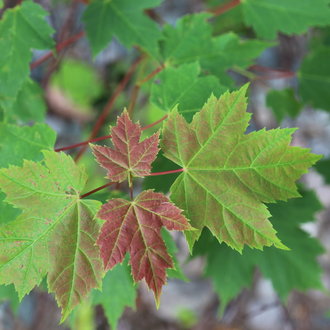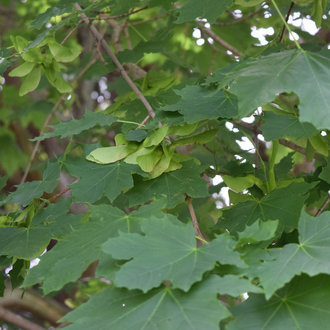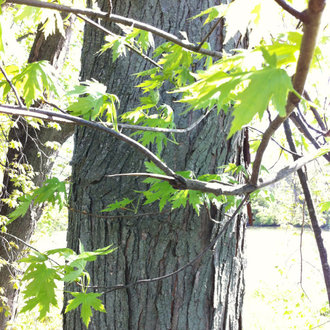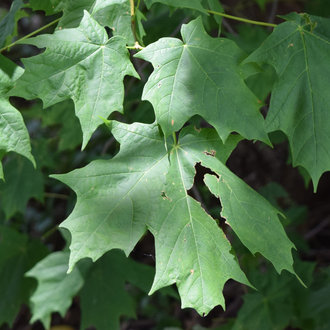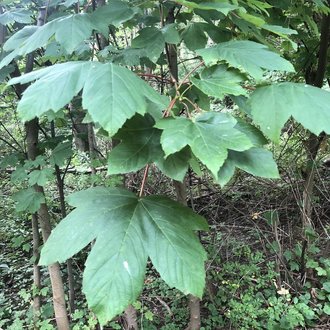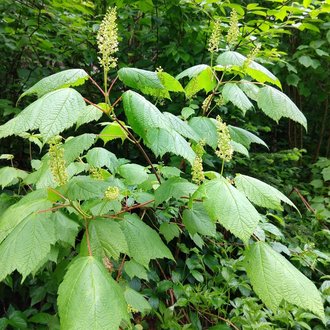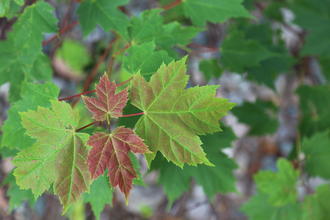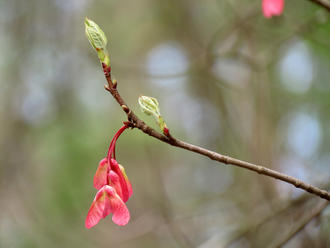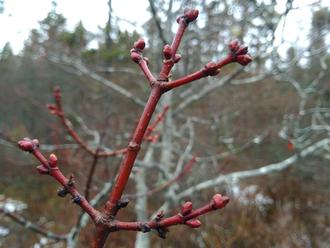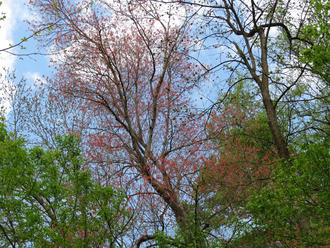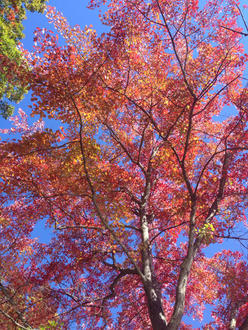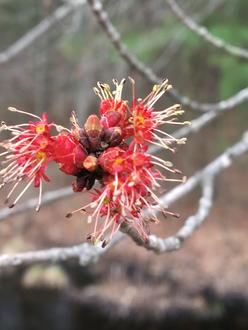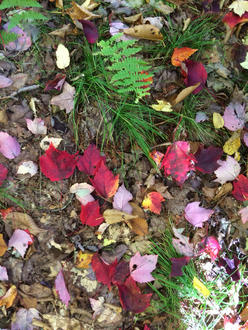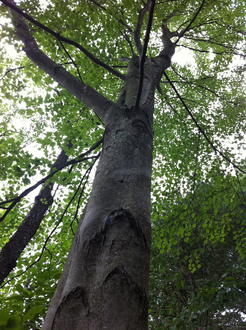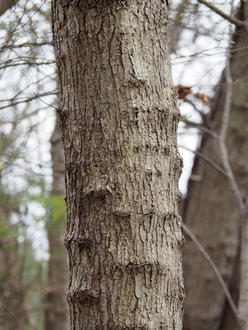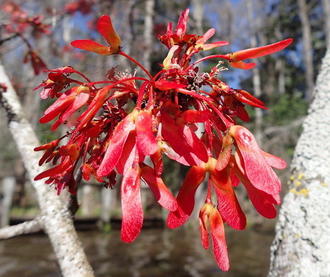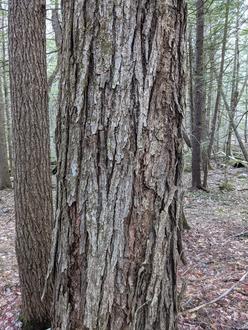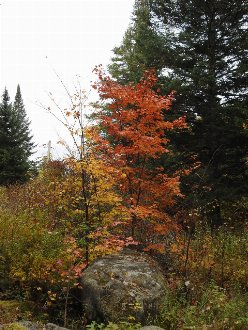Red Maple (Acer rubrum L.)
↑Summary
The most abundant tree species in North America, and a habitat generalist, native to a wide range across the eastern part of the continent.
↑Range - Expand
| Legend | Color |
| Native | |
| Native or Not Present | |
| Introduced or Not Present | |
| Native or Expanded | |
| Native or Introduced |
This tentative map is based on our own research. It may have limited data on Canada and/or Mexico, and there is some subjectivity in our assignment of plants as introduced vs. expanded. Read more in this blog post.
Although this plant occurs somewhere in each of these regions, it may only occur in a small part of some or all of them.
USDA shows this species as native to Lane county, Oregon. It is not native there and this is an artifact of the USDA not distinguishing between native status within different regions in the continental US. BONAP marks as "adventive" on west coast and Iowa.
↑Description & Identification
In part because the red maple is highly variable, it can be confused with numerous other maple species.
↑Similar Plants
↑Habitat
A habitat generalist, red maple tolerates a broad range of conditions and is found in a range of habitats. Often found, paradoxically, both on drier and wetter sites, as it tolerates both drought and flooding better than some species. Tolerates full sun and part shade, and almost any soil types, and has a slight preference for somewhat acidic soils. More shade-tolerant towards the north of its range.
Although tolerant of dry conditions, it is fire intolerant, and fire supression has increased the prevalance and dominance of this species on drier sites. However, it colonizes recently burned sites, and will often survive to reproductive maturity on these sites if fire does not return at frequent enough intervals.
Found in floodplains and other bottomland forests, swamps, upland forests and ridges, forested areas along roads and railways, and in mixed coniferous-deciduous forests. In much of its range, a dominant canopy tree only on wetter sites, and a more minor component of a wide range of other forest types.
On many sites, functions as an early-to-mid-successional species, and sometimes as a pioneer species, but it is eventually replaced by more shade-tolerant species. However, it can persist as a climax species on sites where other more tolerant species cannot survive, such as poorly-drained sites.
Humans have increased the habitat for red maple across its range by creating more disturbance, gaps, and edge habitat, and widely clearing old-growth forests, creating more early-to-mid-successional forests in which it thrives.
↑Life Cycle
Red maple has a short life cycle with high seed production, but considerable variability and adaptability in response to varied conditions.
Most seeds germinate from seed within 10 days after falling; a small portion of seeds overwinter and germinate the following year. Seedlings germinate under a wide range of lighting, moisture, and soil conditions. Seedlings establish under a forest canopy and survive 3-5 years under moderate shade; more shade-tolerant towards the northern edge of its range.
Trees can flower and produce seed as young as 4 years of age, if conditions are favorable for rapid growth. More typically, seed production starts around 8 years, or longer for trees that began their life cycle under a closed forest canopy only to be released later. Flowers early in spring, before vegetative bud development; seed matures before leaves are mature. Mature trees typically produce good seed crops every other year, but may occasionally produce bumper crops. Seeds are wind-dispersed.
Seeds do not persist in the seed bank; seeds found in the soil tend to have low viability.
Individual plants are able to vigorously resprout after being damaged or top-killed by fire or mechanical damage. Resprouting is usually limited to the root crown; this plant does not reproduce vegetatively beyond such resprouts.
Individual trees' lifespans may be as much as 150 years or rarely 200, but more commonly 80-100 years or less. Lifepsan is limited by its soft wood, making it prone to mechanical damage and rot.
↑Uses
Widely planted as a landscaping plant and street tree, where it is valued for its attractive bold red fall foliage, and adaptability to just about any conditions, including urban conditions with compacted soil and exposure to pollution. Many cultivars exist.
Its single-trunk growth habit, with numerous and smaller side-branches, is more suited to a street tree and shade tree than the silver maple, which often grows with multiple, large, heavy trunks, and is prone to dropping large limbs. It is more suited to urban conditions than the sugar maple.
Its wood is valued for its availability, lower price, and good workability. Classified as "soft maple" along with several other species, contrasting with "hard" maple (i.e. black and sugar maple). However, one of the harder woods among the "soft maple" grouping. Used for pulpwood, as well as boxes and crates, and occasionally, musical instruments or turned objects. Its use is limited by poor durability.
↑Related Plants
Numerous other maples, including both native and introduced, co-occur with this species.
Of these, it is closely related to the silver maple (Acer saccharinum), with which it can hybridize, forming the so-called Freeman maple, Acer × freemanii. However, in spite of the two species being able to grow in similar conditions, they uncommonly occur close together in the wild. Although the hybrid is naturally occurring, human influence and widespread planting of both species has resulted in them hybridizing more.
↑Links & External Resources
• Red Maple | The Wood Database (About This Site)
• Red Maple | Fire Effects Information System (FEIS) (About This Site)
• Acer rubrum (Red Maple) | Illinois Wildflowers (About This Site)
• Acer rubrum (Red Maple) | USDA PLANTS Database (About This Site)
• Acer rubrum | Go Botany (About This Site)
• Acer rubrum (Red Maple) | Missouri Botanical Garden Plant Finder (About This Site)
• Red Maple | Virginia Tech Dendrology Factsheets (About This Site)
• Redmaple | Silvics of North America (About This Site)
• Acer rubrum | Biota of North America Project (BONAP) (About This Site)
• Acer rubrum | NatureServe Explorer (About This Site)
• Acer rubrum | Missouri Plants (About This Site)
• Red Maple | Maryland Biodiversity Project (About This Site)
• Acer rubrum L. (Red Maple) | Digital Atlas of the Virginia Flora (About This Site)



